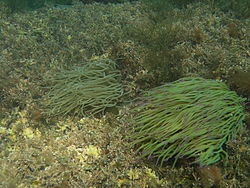- Snakelocks anemone
-
Snakelocks Anemone 
Two Snakelock's Anemones Scientific classification Kingdom: Animalia Phylum: Cnidaria Class: Anthozoa Order: Actiniaria Family: Actiniidae Genus: Anemonia Binomial name Anemonia viridis
Forskål, 1775The snakelocks anemone (Anemonia viridis, formerly A. sulcata) is a sea anemone found in the eastern Atlantic ocean to the Mediterranean sea.
The tentacles of anemones in deep or murky water can be a grey colour but are otherwise usually a deep green colour with purple tips. This is due to the presence of symbiotic algae within the tentacles that use sunlight as an energy source. Since the anemones benefit from this they prefer brightly lit shallow waters. The two shown together in the image to the right show a marked difference in colouration. On average the snakelock anemone is 8 cm large.
Contents
Reproduction
Unlike other cnidarians, anemones (and other Anthozoa) entirely lack the free-swimming medusa stage of the life cycle; the polyp produces eggs and sperm, and the fertilized egg develops into a planula that develops directly into another polyp.
Anemones tend to stay in the same spot until conditions become unsuitable (prolonged dryness, for example), or a predator attacks them. In that case anemones can release themselves from the substrate and use flexing motions to swim to a new location. Most sea anemones attach temporarily to submerged objects; a few thrust themselves into the sand or live in furrows; a few are parasitic on other marine organisms.[1]
The sexes in sea anemones are separate in some species, while others are protandric hermaphrodites. The gonads are strips of tissue within the mesenteries. Both sexual and asexual reproduction can occur. In sexual reproduction males release sperm to stimulate females to release eggs, and fertilization occurs. Anemones eject eggs and sperm through the mouth. The fertilized egg develops into a planula, which settles and grows into a single polyp. In asexual reproduction extratentacular budding occurs, a type of fission, where the anemone will split roughly in half generally through the mouth.
Animal Husbandry
Snakelock anemones (anemonia sulcata / viridis) are fast becoming a widely kept species in aquaria especially within Europe. It rapidly adapts to aquarium life as they are extremely adaptable to various conditions. Reports stand that clown fish from the subfamily Amphiprioninae in the family Pomacentridae will use this anemone as a mutualistic relationship even though they are found in different ecological or environmental areas.
Gastronomy
This anemone is consumed in southwestern Spain, around Gulf of Cádiz region, under the name "ortiguillas de mar" (literally, little sea nettles, because of their urticant properties before cooked) or simply "ortiguillas". The whole animal is marinated in vinegar, then it is coated in a tempura-like batter and deep-fried in olive oil.[1] Ortiguillas are offered in some coastal Andalusian restaurants as a delicacy. They are similar in appearance and texture to croquettes, but having an intense seafood taste.
Gallery
-
A Snakelocks anemone in a rock pool.
References
External links

This cnidarian-related article is a stub. You can help Wikipedia by expanding it. -





